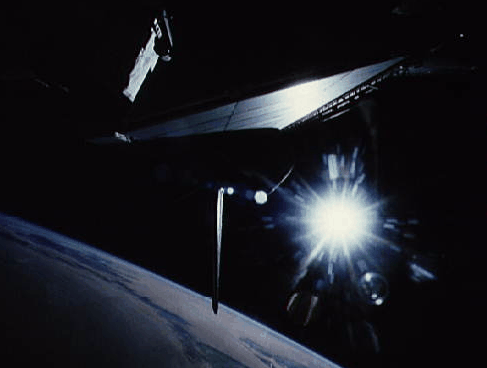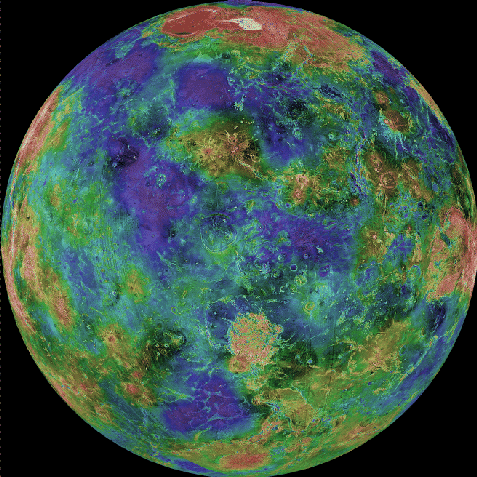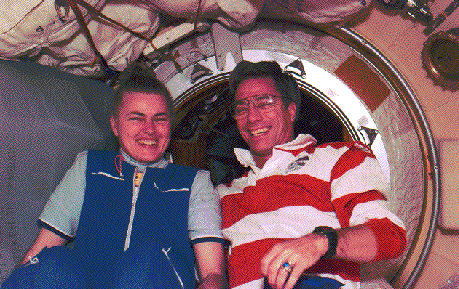NASA APOD #461-468
#461 Information: September 22, 1996
“Today the Sun crosses the celestial equator heading south -- marking the Autumnal Equinox, the first day of Autumn. Equinox means equal night and with the Sun on the celestial equator, Earthlings will experience 12 hours of daylight and 12 hours of darkness. Then, for those in the northern hemisphere, the days will begin to grow shorter with the Sun marching lower in the sky as winter approaches. A few weeks after the Autumnal Equinox of 1994, the Crew of the Shuttle Endeavor recorded this image of the Sun poised above the Earth's limb. The glare illuminates Endeavor's vertical tail (pointing toward the Earth) along with radar equipment in the payload bay. Information: Thursday, September 26 - A Total Lunar Eclipse"
Copyright: Public domain
#462 Information: September 23, 1996
“If Venus weren't so cloudy it would be more similar to Earth. This picture by the Galileo spacecraft shows just how cloudy Venus is. Venus is very similar to Earth in size and mass - and so is sometimes referred to as Earth's sister planet - but Venus has a quite different climate. Venus' thick clouds and closeness to the Sun (only Mercury is closer) make it the hottest planet - much hotter than the Earth. Humans could not survive there, and no life of any sort has ever been found. When Venus is visible it is usually the brightest object in the sky after the Sun and the Moon. More than 20 spacecraft have visited Venus including Venera 9, which landed on the surface, and Magellan, which used radar to peer through the clouds and make a map of the surface. This visible light picture of Venus was taken by the Galileo spacecraft now in orbit around Jupiter. Many things about Venus remain unknown, including the cause of mysterious bursts of radio waves."
Copyright: Public domain
#463 Beneath Venus' Clouds September 24, 1996
“If the thick clouds covering Venus were removed, how would the surface appear? Using an imaging radar technique, the Magellan spacecraft was able to lift the veil from the Face of Venus and produce this spectacular high resolution imageof the planet's surface. Red, in this false-color map, represent mountains, while blue represents valleys This 3-kilometer resolution map is a composite of Magellan images compiled between 1990 and 1994. Gaps were filled in by the Earth-based Arecibo Radio Telescope. The large yellow/red area in the north is Ishtar Terra featuring Maxwell Montes, the largest mountain on Venus. The large highland regions are analogous to continents on Earth. Scientists are particularly interested in exploring the geology of Venus because of its similarity to Earth. Information: Thursday, September 26 - A Total Lunar Eclipse"
Copyright: Public domain
#464 Bright Stars and Dark Clouds
Credit: September 25, 1996
“Did you ever feel like a black cloud was following you around? Well don't feel bad - this even happened to the bright young stars of the open cluster NGC 6520. On the left are the cluster's bright blue stars. They formed only millions of years ago - much more recently than our ancient Sun which formed billions of years ago. On the right is an absorption nebula from which the stars might have formed. This nebula contains much opaque dust which blocks visible light from the many stars that would have been seen in the background. The study of open clusters is valuable for many reasons which include the understanding star formation and the calibration of the distance scale of our universe. Information: Thursday, September 26 - A Total Lunar Eclipse"
Copyright: Anglo-Australian Telescope Board
#465 Tonight: A Total Lunar Eclipse
Credit and Copyright: September 26, 1996
“Tonight brings the last total lunar eclipse visible from North America until the year 2000 - with the Moon becoming completely immersed in Earth's shadow. The above time-lapse photograph shows a lunar eclipse that occurred in April 1993. Tonight's eclipse will begin at 8:12 pm Eastern Daylight Time, with totality extending from 10:19 pm to 11:29 pm. In North and South America, the Moon will be just rising at the beginning of the eclipse. In West Europe and Africa, tonight's lunar eclipse will be visible before the dawn of September 27th. The Moon is not expected to become completely dark - usually it has a slight red glow caused by sunlight refracted through the Earth's dusty atmosphere - but every lunar eclipse is slightly different. This year's eclipse will be enhanced by the proximity of bright Saturn just 3 degrees away."
Copyright: Public domain
#466 Welcome Home Shannon Lucid
Credit: September 27, 1996
“Today is Shannon Lucid's first day on Planet Earth in six months. Her stay aboard Russia's Mir Space Station was of record length - the longest stay of any American in space ever. During her time in orbit around the Earth, Lucid, a biochemist, did many things including experiments on the effect of weightlessness on the human body. Pictured above, Lucid greets the astronaut that will replace her on Mir, John Blaha. "
Copyright: Public domain
#467 A Soyuz at Mir
Credit: September 28, 1996
“Pictured above is a three person Russian Soyuz capsule with wing-like solar panels extended, joined to the Mir space station. In Russian soyuz means "union" and indeed one of the milestones achieved by a Soyuz spacecraft was an orbital union with a US Apollo command module during the first international space mission (Apollo-Soyuz) in 1975. The Soyuz TM spacecraft are specially modified for use with the Mir as ferries for cosmonauts and astronauts and also as lifeboats, should the need arise. This image is from an electronic still camera used by the crew of the Space Shuttle Atlantis during their latest Mir visit to pick up astronaut Shannon Lucid and drop off John Blaha."
Copyright: Public domain
#468 The X-Ray Moon
Credit: September 29, 1996
“This X-Ray image of the Moon was made by the orbiting Roentgen Observatory Satellite (ROSAT) in 1990. It shows three distinct regions: a bright X-ray sky, a bright part of the Moon, and a relatively dark part of the Moon. The bright X-ray sky is due to the diffuse cosmic X-ray background. The bright lunar crescent shines because it reflects X-rays emitted by the Sun. The dark lunar face is in shadow and so stands stands out from the relatively bright background - but, surprisingly it is not completely dark! Where do those X-rays from? They are currently thought to result from energetic particles from the solar wind bombarding the lunar surface."
Copyright: Public domain
Upvote! Resteem! Comment! As you like it! Thank you for attention!







